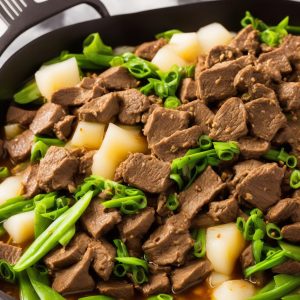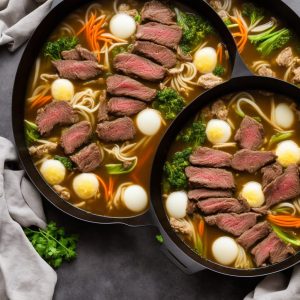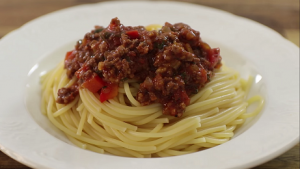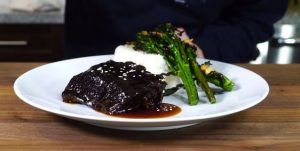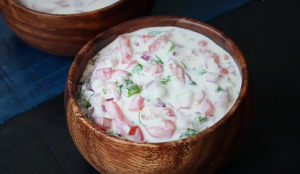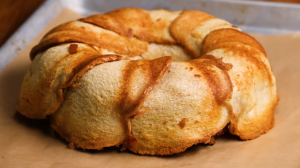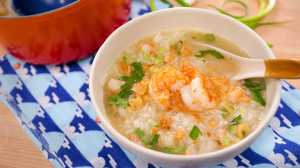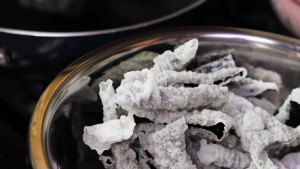Sukiyaki is a savory Japanese hot pot dish typically enjoyed in the colder months. This dish is cooked at the table in a shallow iron pot and features a delectable combination of thinly sliced beef, tofu, vegetables, and noodles simmered in a flavorful broth. The sweetness from the sugar and the umami from the soy sauce creates a harmonious balance that warms not just your body but also your heart.
For this traditional Sukiyaki recipe, you might need to visit an Asian supermarket to find some of the ingredients. The most essential ingredients that may not be common in all homes include sake, soft tofu, napa cabbage, and shirataki noodles. Sake, a Japanese rice wine, is used to add depth to the broth. Soft tofu, different from the firm tofu, adds a contrasting texture. Napa cabbage, also known as Chinese cabbage, has a milder and sweeter flavor than regular cabbage. Shirataki noodles, also known as konjac noodles or miracle noodles, are gluten-free, low-calorie noodles that absorb the flavors of the broth beautifully.
Ingredients for Traditional Sukiyaki
Angel hair: Thin, light noodles that cook quickly and soak up the flavours of the broth nicely.
Cooking oil: Used to sauté the beef and vegetables, adding a rich taste.
Sugar: Balances the saltiness of the soy sauce and adds a hint of sweetness.
Club steak: This is the star of the dish, providing a rich, meaty flavor.
Scallions: They give the dish a nice crunch and a mild onion flavor.
Chicken broth: Forms the base of the soup, adding depth of flavor.
Soy sauce: Gives the dish it's characteristic salty, umami flavor.
Sake: Adds a subtle complexity to the broth.
Soft tofu: It's delicate texture contrasts well with the other ingredients.
Napa cabbage: Its sweet, mild flavor balances the stronger flavors in the dish.
Mushrooms: They add an earthy flavor and meaty texture to the dish.
Spinach: Adds a touch of color and a variety of nutrients.
One reader, Brok Dial says:





This traditional sukiyaki recipe is a game-changer! The flavors are rich and savory, and the combination of ingredients creates a truly authentic and delicious dish. The cooking process is straightforward, and the end result is a delightful and satisfying meal that's perfect for sharing with loved ones. Highly recommended!
Mastering the Techniques for Traditional Sukiyaki
How to prepare the pasta: Boil the angel hair in a large pot of salted water until just done, about 3 minutes. Then, drain, rinse with cold water, and drain thoroughly.
How to caramelize sugar: Heat a large nonstick frying pan over moderately high heat. Add the oil and sprinkle the sugar into the pan. Let it sit until the sugar begins to turn golden brown, about 1 minute. Stir until the sugar turns a medium brown.
How to brown the steak: Add the steak in about five batches, turning quickly with tongs until browned and just done, about 1-2 minutes in total. Remove the steak from the pan.
How to glaze the beef with caramelized sugar: The sugar should glaze the beef with brown caramel. If the pan gets too hot, reduce the heat to moderate so the sugar won't burn.
How to cook the scallions: Add the scallions to the pan and cook, stirring, until browned, about 2 minutes.
How to simmer the sukiyaki: In the pasta-cooking pot, combine the pasta, beef, scallions, broth, soy sauce, sake, tofu, cabbage, and mushrooms. Bring to a simmer and cook, stirring, until the vegetables are almost tender, about 2 minutes.
How to wilt the spinach: Add the spinach and continue cooking until wilted, about 30 seconds longer.
How To Make Sukiyaki
Stay warm on cold nights by whipping up this classic Japanese sukiyaki recipe, made of tender beef, seasoned broth, tofu, and pasta!
Serves:
Ingredients
- ½lbangel hair
- 3tbspcooking oil
- ¼cupsugar
- 1½lbclub steak
- 10scallions,including green tops
- ¾cupchicken broth,low sodium
- cupsoy sauce
- cupsake,or dry white wine
- ½lbsoft tofu
- ½lbnapa cabbage
- ¼lbmushrooms
- ½lbspinach
Instructions
-
In a large pot of boiling, salted water, cook the pasta for about 3 minutes until just done. Drain. Rinse with cold water and drain thoroughly.
-
Heat a large nonstick frying pan over moderately high heat. Add the oil and sprinkle the sugar into the pan.
-
Let sit for about 1 minute, until the sugar begins to turn golden brown. Stir until the sugar turns a medium brown.
-
Add the steak, in about five batches, turning quickly with tongs, for 1 or 2 minutes in all, until browned and just done. Remove.
-
The sugar should glaze the beef with brown caramel. If the pan gets too hot, reduce the heat to moderate so the sugar won’t burn.
-
Add the scallions; cook, stirring, for about 2 minutes until browned.
-
In the pasta-cooking pot, combine the pasta, the beef and any accumulated juices, the scallions, broth, soy sauce, sake, tofu, cabbage and mushrooms and bring to a simmer.
-
Simmer, stirring, for about 2 minutes, until the vegetables are almost tender. Add the spinach and continue cooking for about 30 seconds longer until wilted.
-
Serve warm, and enjoy!
Nutrition
- Calories: 718.24kcal
- Fat: 28.39g
- Saturated Fat: 7.37g
- Trans Fat: 0.85g
- Monounsaturated Fat: 14.19g
- Polyunsaturated Fat: 5.59g
- Carbohydrates: 64.41g
- Fiber: 5.00g
- Sugar: 17.44g
- Protein: 54.43g
- Cholesterol: 105.11mg
- Sodium: 238.02mg
- Calcium: 245.35mg
- Potassium: 1359.26mg
- Iron: 7.27mg
- Vitamin A: 418.36µg
- Vitamin C: 49.30mg
One Simple Technique to Elevate Your Sukiyaki Game
When preparing your sukiyaki, it's important to pay close attention to the caramelization of the sugar. This process is crucial in achieving the desired sweetness and depth of flavor in the dish. However, be careful not to burn the sugar as it can turn bitter and ruin the taste. If you notice the sugar turning too dark too quickly, don't hesitate to lower the heat. Remember, cooking is all about control and adjustment.
Time-Saving Tips for Making Sukiyaki at Home
Prep ahead: Chop and prepare all the ingredients in advance to streamline the cooking process.
One-pot wonder: Consider using a large pot or skillet to cook the sukiyaki in one vessel, minimizing cleanup.
Quick cook: Opt for thinly sliced beef to reduce cooking time and ensure the meat cooks quickly in the broth.
Efficient assembly: Arrange all the ingredients in an organized manner before starting to cook for a smoother cooking process.
Multi-task: While the sukiyaki simmers, use the time to set the table and prepare any accompanying side dishes.
Fresh and pre-cut: Utilize pre-cut vegetables and pre-sliced beef to cut down on prep time without sacrificing freshness.
Easy cleanup: Line the serving dishes with parchment paper or lettuce leaves for easy cleanup after the meal.
Flavor shortcut: Consider using a pre-made sukiyaki sauce to save time on preparing the broth from scratch.
Substitute Ingredients For Sukiyaki Recipe
- angel hair - Substitute with udon noodles: Udon noodles are thicker and chewier, providing a heartier texture to the dish.
- cooking oil - Substitute with sesame oil: Sesame oil adds a nutty flavor that complements the other ingredients in the sukiyaki.
- club steak - Substitute with sirloin steak: Sirloin steak is a lean and flavorful cut that works well in sukiyaki.
- scallions - Substitute with leeks: Leeks have a similar mild onion flavor and hold up well when cooked in the sukiyaki.
- low sodium chicken broth - Substitute with vegetable broth: Vegetable broth adds a savory depth of flavor and works well with the other ingredients.
- soy sauce - Substitute with tamari: Tamari is a gluten-free alternative to soy sauce with a rich and deep flavor.
- sake or dry white wine - Substitute with mirin: Mirin adds a touch of sweetness and depth of flavor to the sukiyaki.
- soft tofu - Substitute with firm tofu: Firm tofu holds its shape better when simmered in the sukiyaki broth.
- napa cabbage - Substitute with bok choy: Bok choy has a similar mild flavor and tender texture that complements the sukiyaki.
- mushrooms - Substitute with shiitake mushrooms: Shiitake mushrooms add a rich and earthy flavor to the sukiyaki.
- spinach - Substitute with chrysanthemum greens: Chrysanthemum greens have a slightly bitter flavor that adds complexity to the dish.
Presenting Sukiyaki: Tips for a Beautiful and Appetizing Dish
Elevate the plating: Arrange the sukiyaki in a traditional donabe or a beautiful ceramic bowl to showcase the rich and vibrant colors of the dish. The presentation should be visually appealing and inviting, with each ingredient thoughtfully placed to create a harmonious balance.
Garnish with precision: Sprinkle thinly sliced scallions and sesame seeds over the sukiyaki to add a pop of color and texture. The garnish should be delicately placed to enhance the overall aesthetic without overpowering the dish.
Incorporate artistic drizzling: Drizzle a small amount of toasted sesame oil over the sukiyaki just before serving to add a glossy finish and a hint of nutty aroma. The drizzling should be done with precision to create an elegant and refined presentation.
Utilize elegant serving ware: Present the sukiyaki alongside a set of traditional chopsticks and a beautiful lacquerware serving spoon to elevate the dining experience and showcase the dish's cultural significance.
Emphasize the umami essence: Highlight the umami flavors of the sukiyaki by serving it with a side of pickled ginger and wasabi. These condiments should be elegantly arranged to complement the dish and provide a burst of contrasting flavors.
Essential Tools for Making Traditional Sukiyaki
- Large pot: A large pot is essential for boiling pasta and simmering the sukiyaki ingredients.
- Nonstick frying pan: A nonstick frying pan is used for browning the steak and scallions without sticking.
- Tongs: Tongs are necessary for turning and handling the steak while browning.
- Pasta-cooking pot: This pot is used for cooking the pasta and then combining all the sukiyaki ingredients for simmering.
- Cooking oil: Cooking oil is used for browning the steak and scallions in the nonstick frying pan.
- Large spoon: A large spoon is used for stirring the sukiyaki ingredients while simmering.
- Colander: A colander is used for draining the cooked pasta.
- Knife: A knife is essential for slicing the scallions, tofu, napa cabbage, and mushrooms.
- Cutting board: A cutting board is used for preparing and slicing the vegetables and tofu.
- Measuring cup: A measuring cup is used for accurately measuring the chicken broth, soy sauce, and sake.
- Saucepan: A saucepan is used for preparing the sukiyaki sauce by combining the chicken broth, soy sauce, and sake.
- Stove: A stove is required for cooking and simmering the sukiyaki ingredients.
Storing and Freezing Sukiyaki for Later Enjoyment
Here are the storing and freezing guidelines for traditional sukiyaki:
- Sukiyaki is best enjoyed fresh, but if you have leftovers, store them in an airtight container in the refrigerator for up to 3 days. The napa cabbage and spinach may become slightly soggy, but the flavors will meld together nicely.
- To reheat, gently warm the sukiyaki in a pan over medium heat until heated through, stirring occasionally. Add a splash of chicken broth or water if the sauce has thickened too much.
- If you want to freeze sukiyaki, it's best to freeze the components separately:
- Cook the steak and freeze it in a freezer-safe container or bag for up to 2 months.
- Blanch the vegetables (except for the spinach) in boiling water for 1-2 minutes, then shock them in an ice bath. Drain well and freeze in a single layer on a baking sheet. Once frozen, transfer to a freezer-safe container or bag and store for up to 1 month.
- Freeze the tofu in a separate container for up to 1 month. Note that the texture may change slightly after freezing.
- Prepare the sauce and freeze it in an ice cube tray. Once frozen, transfer the cubes to a freezer-safe bag and store for up to 3 months.
- To reheat frozen sukiyaki, thaw the components in the refrigerator overnight. Reheat the sauce in a pan, then add the steak, vegetables, and tofu. Simmer until heated through, then add the fresh spinach and cook until wilted.
How to Reheat Sukiyaki Leftovers for Optimal Taste
Reheat the sukiyaki in a large pot or wok over medium heat. Stir gently to ensure even heating and to prevent the noodles from sticking together. Add a splash of chicken broth or water if the mixture seems too dry.
For a quicker reheating method, microwave the leftover sukiyaki in a microwave-safe dish. Cover the dish with a damp paper towel to prevent the noodles from drying out. Microwave on high for 1-2 minutes, stirring halfway through, until heated through.
If you have leftover beef and vegetables separate from the noodles, reheat them in a skillet over medium heat until warmed through. Add the reheated noodles to the skillet and toss everything together until well combined and heated through.
For a crispy texture, reheat the leftover sukiyaki in a large skillet or wok over medium-high heat. Add a small amount of oil to the pan and stir-fry the noodles, beef, and vegetables until crispy and heated through.
If you have a lot of leftover broth, reheat it separately in a pot over medium heat until simmering. Add the leftover noodles, beef, and vegetables to the hot broth and stir until everything is heated through.
Interesting Trivia About Sukiyaki's History and Culture
The traditional sukiyaki recipe is a popular Japanese hot pot dish that typically includes thinly sliced beef, tofu, vegetables, and noodles cooked in a sweet and savory soy sauce-based broth. This dish is often enjoyed during the colder months and is a great way to bring family and friends together for a warm and comforting meal. Sukiyaki is also known for its interactive cooking style, where everyone gathers around the hot pot to cook and enjoy the ingredients together, making it a fun and communal dining experience.
Sukiyaki: An Economical Choice for Home Cooking?
This traditional sukiyaki recipe is moderately cost-effective for a household. The use of club steak and low sodium chicken broth may increase the overall cost, but the dish's portion size and rich flavors make it suitable for a special occasion. The approximate cost for a household of 4 people is around $30-$40. The overall verdict rating for this recipe is 8/10, considering the quality of ingredients and the delightful dining experience it offers.
Is Sukiyaki a Healthy or Unhealthy Dish?
The traditional sukiyaki recipe, while delicious, has some aspects that could be considered unhealthy. The use of sugar and oil for browning the beef adds extra calories and fat to the dish. Additionally, the club steak, although a good source of protein, is also high in saturated fat. The soy sauce and chicken broth contribute to the dish's high sodium content, which may be a concern for those watching their salt intake.
On the positive side, the recipe incorporates a variety of vegetables, such as scallions, napa cabbage, mushrooms, and spinach, which provide essential vitamins, minerals, and fiber. The soft tofu is also a healthy addition, offering a good source of plant-based protein and calcium.
To make this recipe healthier, consider the following suggestions:
- Use a leaner cut of beef, such as sirloin or tenderloin, to reduce the amount of saturated fat
- Replace the sugar with a small amount of honey or omit it altogether, relying on the natural sweetness of the vegetables and the caramelization of the beef for flavor
- Reduce the amount of oil used for browning the beef, or use a healthier alternative like olive oil or avocado oil
- Opt for low-sodium soy sauce and chicken broth to decrease the overall sodium content
- Increase the proportion of vegetables in the dish, particularly nutrient-dense options like spinach, mushrooms, and cabbage
- Consider using whole wheat or buckwheat noodles instead of angel hair pasta for added fiber and nutrients
Editor's Take on the Deliciousness of Traditional Sukiyaki
This traditional sukiyaki recipe offers a delightful blend of flavors and textures. The use of angel hair pasta adds a unique twist to the dish, while the caramelized sugar and club steak create a rich and savory base. The addition of scallions, tofu, and a variety of vegetables adds depth and freshness to the dish. The suggested wine pairing of a pinot noir from California is a bold and adventurous choice, adding a fruity complement to the meal. Overall, this recipe presents a modern interpretation of a classic dish, perfect for those looking to explore new culinary experiences.
Enhance Your Sukiyaki Recipe with These Unique Side Dishes:
Exploring Dishes Similar to Traditional Sukiyaki
Appetizer and Dessert Ideas to Complement Your Sukiyaki Meal
Why trust this Sukiyaki Recipe:
This traditional sukiyaki recipe offers a perfect balance of flavors and textures, ensuring a delightful dining experience. The combination of tender club steak and fresh vegetables creates a harmonious blend, while the addition of tofu adds a creamy element. The use of low sodium chicken broth and soy sauce enhances the savory profile, and the inclusion of sake or dry white wine infuses depth into the dish. The careful caramelization of sugar adds a touch of sweetness, elevating the overall taste. Trust in this recipe for an authentic and satisfying sukiyaki experience.
Was this page helpful?
Have your own special recipe to share? Submit Your Recipe Today!




